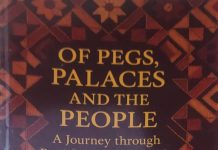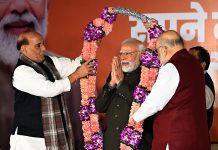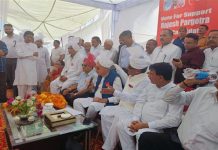 A memoir by a former IAS officer normally has fewer reasons to be contentious. But there is every reason for it to be so if the bureaucrat happens to have been posted in Kashmir and the memoir touches upon a range of sensitive
A memoir by a former IAS officer normally has fewer reasons to be contentious. But there is every reason for it to be so if the bureaucrat happens to have been posted in Kashmir and the memoir touches upon a range of sensitive
issues which also have fraught political overtones. ‘Unmasking Kashmir’ by retired IAS officer Sonali Kumar is one such memoir.
The 256 page book is a top “outsider” bureaucrat’s account of Kashmir, the first of its nature. Another first to its credit is that Kumar is a woman and she has something to say about alleged gender discrimination in the state too.
But her general sounding revelations about harassment of women pale in comparison to her account of how the state treats its bureaucrats from other parts of India. This has become a subject of bitter debate in the state.
Though the account talks about the unique problems faced by ‘outsider’ IAS officers, it invariably runs up against the fraught political and historical questions which make the state so extraordinarily troubled in the first place.
Kumar laments that IAS officers from outside the state “can’t buy property, can’t educate her children in any technical — medical or engineering college, can’t get her spouse or children to find employment with the State Government, can neither vote in nor stand for any state-level elections even after retirement, can’t even get her son married to a local girl because that will immediately extinguish that girl’s state-subject status,” and so on.
She blames the law passed by the Maharaja of J&K in 1927 for this. But in the state this law is directly connected to Article 35A, the constitutional provision extended to the state by the President of India in 1954 which enables the state government to define state subjects and forbid outsiders from settling in the state. This law currently faces a tough challenge in the Supreme Court.
“The law (in 1927) was enacted by Maharaja’s Hindu advisors primarily to keep other Hindus of India out of J&K,’ writes Kumar. “And the same law is now coming in handy for Kashmiri Muslims to keep everyone else out!”.
But in Kashmir Kumar’s grouse hits a raw nerve. It is seen less as a former IAS officer’s account of her personal experience or that of her tribe and more as yet another voice in support of the perceived effort to dilute the state’s special constitutional position guaranteed under Article 370. In popular perception such a dilution is understood as a thinly-veiled design to alter the state’s demography.
In Kumar’s narration, however, there are hardly any nods to this inherent complicacy of the situation. On the contrary, she chooses to foreground an outsider IAS officer’s predicament in the state, to the point of either trivializing the overarching political issues facing the state or treating them as secondary to
her plight.
The book shows Kumar invariably bitter about her thirty-six-and-a-half years of service in Kashmir. But it is the ‘us-versus-them’ trope underpinning her telling that is deeply troubling; it is simplistic in that it evacuates the situation in the state of its political and historical context. Kumar gratuitously sets herself up as a defender of India’s integrity against anti-national Kashmiris. This approach ironically brackets even those who are part of the establishment with the separatists, one of them a former Chief Secretary of the state who is said to have been hosting Hurriyat leaders at his home and as a result forced to resign.
She largely sees the struggle in Kashmir aroused by the hate against New Delhi, pure and simple, and not necessarily deriving from any historical wrongs. Her narrative on the state doesn’t even distantly acknowledge the possible case of a genuine grievance in Kashmir, a serious omission that makes the memoir a witting or unwitting part of the vilification campaign launched against the state by sections of national media, particularly by some television channels. The omission also makes the book a part of the dominant ideological narrative on the state in India today.
“What I represented, which in my Sari and Bindi attire meant “Indianness,” she writes. And this ‘Indianness’, she facilely concludes, makes her an “outsider” in J&K. In fact, the theme of an outsider runs through the narrative.
“But what about the curses of that “outsider” to J&K? Are you sure the present problems are only communal, i.e. how can the Muslims in J&K live with a Hindu India? Or instigated by Pakistan? Or because of the Kashmiri’s genuine desire to separate from India?,” Kumar questions.
She continues at another place: “My heart sank when I heard the word outsider for the first time. How could I be an outsider in my own country? I was an Indian first and then anything else. Little did I realise then that the entire Kashmir problem was because of the apartheid regime that existed. That regime which divided humanity into two: insiders and outsiders”.
Observations like these have elicited hostile reactions in Kashmir. The reviews in local newspapers and comments in social media have been trenchantly critical of Kumar. “Apparently, the idea is to add to the narrative that rightwing parties have developed in last few years within and outside the courtrooms. It is demography in question and the quest for larger integration that is talked about,” writes noted Kashmiri journalist and editor Masood Hussain in his review of the book.
Another review written by one Shama Jahangir was titled ‘Unmasking Kashmir unmasks Sonali’. Similarly, former bureaucrat Irfan Yasin in his Facebook post recalls Kumar as “an arrogant and self-centred person with a false sense of superiority”.
“She never tried to identify with the state or its problems and has been part of these insider outsider presumed sentiments to the extent of being stupid,” Yasin writes.
One of the interesting anecdotes that Kumar reveals in her book and which has earned it attention in media is about her removal from the post of principal resident commissioner J&K House, New Delhi, for allegedly not serving biryani to a visiting delegation. That might be so but biryani is not the food of Muslims of Kashmir as Kumar seems to suggest and gain sympathy as a consequence. Kashmiri Muslim’s favourite dish is rather Wazwan.
Nor is Secretariat two kilometres from Batamaloo. Or the Secretariat four kilometres from Nedous hotel. This is the distance she claims to have been walking (“yes walking”, to borrow her phrase) during her early days of posting to the state. Both distances are less than half a kilometre.
There are many other details which are factually incorrect: For example, one of the Chief Ministers of Kashmir, according to her, was Ghulam Shah when it was Ghulam Mohammad Shah. Or when she writes that bureaucrat B R Kundal resigned as Chief Secretary and became a minister which is also incorrect. At a time when associating biryani with people whose traditional food is not biryani can gain you easy media attention and some public praise to boot, you can afford to be careless with even basic details about the state where you have spent 37 years of your career.
letters@tehelka.com












